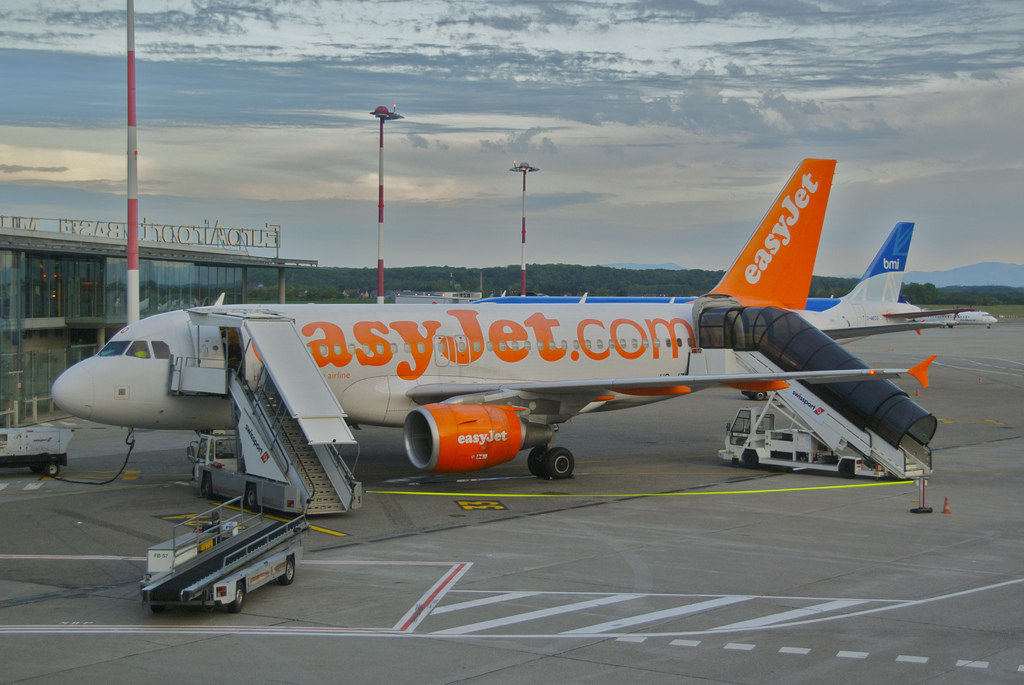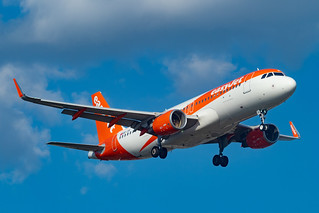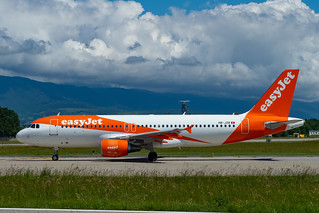Easyjet A319 at Basel on Jul 20th 2014, pilot induced turbulence injures cabin crew
Last Update: December 11, 2017 / 15:06:48 GMT/Zulu time
Incident Facts
Date of incident
Jul 20, 2014
Classification
Accident
Airline
Easyjet Switzerland
Flight number
U2-1174
Departure
Olbia, Italy
Destination
Basel/Mulhouse, France
Aircraft Registration
HB-JZQ
Aircraft Type
Airbus A319
ICAO Type Designator
A319
Airport ICAO Code
LFSB
On Sep 18th 2014 Switzerland's SUST announced an investigation has been opened into the occurrence rated an accident.
On Dec 11th 2017 the SUST released their final report in French concluding the probable cause of the accident was:
The accident is to be attributed to an abrupt movement of the left sidestick to the mechanical stop. This caused a vertical acceleration of +2.33G leading to the fall of a flight attendant receiving a serious injury.
Contributing factors were:
- in speed mode "selected" the crossover from mach to IAS did not happen
- unsuitable scan of aircraft parameters by the pilot flying
- unsuitable handling of the descent parameters by the pilot flying when approaching the maximum permitted speed in normal operation
The aircraft had been enroute at FL380 and was cleared to descend to FL240 with more than 2000fpm rate of descent. The captain (43, ATPL, 8,013 hours total, 2,732 hours on type) was pilot flying and also handled radio at that time, the first officer (43, ATPL, 9,360 hours total, 2,187 hours on type) was busy collecting weather information. The captain initially selected the flight modes to vertical speed and Managed Mach, subsequently to Open Descent (Mach with a target of 0.76 mach) at about FL286. At the same time the aircraft was cleared to descend to FL180. The aircraft was descending at 3700 fpm at 315 KIAS, the vertical speed with target 2500 fpm is activated again, the selected Mach of 0.76 remains active and the IAS continues to increase. The aircraft is being handed off to Zurich Control, the captain selects the new frequency and reports on the new frequency, autothrust begins to accelerate the engines in order to maintain the target Mach of 0.76 reaching 60% N1, the IAS reaches close to the Vmo of 350 KIAS. Clouds are present outside, the captain keeps focussed on the external environment. With the airspeed increasing through 345 KIAS the first officer calls out "Check Speed", the commander recognizes the speed trend reaches the red/back ribbon, selected the Mach target to 0.54 mach and the engine thrust reduces. Descending through FL204 the aircraft reached 349 KIAS. Dissatisfied with the speed management the captain disengaged the autopilot and instinctively pulled the stick back to the mechanical stop returning it to the neutral position over the next 4 seconds. The overspeed horn activates just during this pull, the attitude changes abruptely from -2.5 degrees nose down to 2 degrees nose up causing a vertical acceleration of +2.33G. Two flight attendants in the aft of the cabin facing backwards to monitor the cooking on board fell to the floor, the flight attendant working in the front of the cabin also fell. The open descent mode is engaged again, the autopilot engaged, various uncoordinated speed selections occurred until the speed is selected to 275 KIAS in selected speed, from which point the descent continued normally. Following landing all three flight attendants are being checked by medical services, the seriously injured with a left ankle injury was taken to a hospital.
The SUST analysed that at FL286, when the captain selected the speed mode from managed to selected the aircraft was above the cross over level of 268, hence the autoflight system remained in Mach, the new cross over level was automatically switched to FL305 according to the law defined for this speed mode. The aircraft was already below that cross over level, therefore no automatic cross over occurred during further descent. It would be advisable to put specific notes into the aircraft and operational documentation to emphasize this point in case pilots need to intervene at such flight levels.
The SUST analysed that when the captain selected open descent the flight mode announciators changed to "THR IDLE" and "OP DES" providing no information about the speed reference being Mach or IAS, only the FCU Speed window provides such information. Only when the V/S mode was engaged the thrust channel changed to MACH now providing information about the speed reference being Mach.
The SUST further analysed that the flight was performed with an increased cost index, that lowers the cross over altitude. The captain thus may have been misled to not detect the system had not performed the cross over from Mach to IAS as speed reference.
The SUST continued analysis stating that the sudden and abrupt pull can NOT be attributed to the startle effect as it had been preceded by actions of the FCU in order to prevent overspeed, however, the response by the autopilot was not quick enough. The abrupt sidestick input was possibly induced by an impulsive fear finding the speed trend vector had clearly violated the Vmo limit. Such sudden and abrupt inputs are termed "survival process" by the manufacturer, where sudden up/down stick inputs may be required in windshear or ground proximity warnings, all of which are low altitude maneouvers not applicable to the scenario of this flight. Instead, this maneouver should have been down slowly to control the deflection of the control surfaces.
In addition the existing overspeed protection and overspeed recovery procedures imply that the exceedance of the flight envelope is guarded against by overspeed protection and does not cause any difficulty. However, pilots often see such limits as an absolute border not to be crossed. Conditioned to this notion of danger it is understandable that pilots' first reflex is to avoid such a situation. The prcoedures laid out in the manual recommend to keep the automation on and permit the overspeed prevention and recovery to deal with the scenario even at the risk of Vmo being temporarily being exceeded. It is therefore necessary that pilots train this scenario on the simualtors.
One safety recommendation was issued to EASA with respect to improve pilot documentation with respect to the overspeed limitations.
Metars:
LFSB 201730Z 17004KT 9999 FEW016 FEW040TCU BKN093 19/18 Q1011 TEMPO TSRA=
LFSB 201700Z 00000KT 9999 -RA FEW016 SCT040 BKN093 19/17 Q1011 TEMPO TSRA=
LFSB 201630Z VRB03KT 9999 RA FEW016 SCT040TCU BKN093 20/18 Q1012 TEMPO TSRA=
LFSB 201600Z 24004KT 150V290 9999 SHRA FEW026 SCT040TCU BKN120 20/18 Q1012 TEMPO TSRA=
LFSB 201530Z 28007KT 250V310 9999 SHRA FEW026 SCT040TCU BKN120 21/18 Q1012 NOSIG=
LFSB 201500Z VRB02KT 9999 VCTS FEW026 SCT040CB BKN120 22/18 Q1012 TEMPO TSRA SCT040CB=
LFSB 201430Z VRB03KT 9999 SCT040TCU FEW040 BKN120 23/18 Q1012 TEMPO TSRA FEW040CB=
LFSB 201400Z 13005KT 080V190 9999 FEW026 BKN120 23/18 Q1012 TEMPO TSRA FEW040CB=
LFSB 201330Z 12013KT 9999 FEW026 SCT130 22/18 Q1012 TEMPO TSRA FEW040CB=
LFSB 201300Z 12005KT 080V190 9999 -RA FEW026 SCT093 21/18 Q1012 TEMPO TSRA FEW040CB=
LFSB 201230Z 13010KT 100V160 9999 FEW026 BKN100 21/17 Q1013 NOSIG=
LFSB 201200Z 13007KT 090V160 9999 FEW020 BKN086 BKN120 21/18 Q1013 NOSIG=
Aircraft Registration Data
Incident Facts
Date of incident
Jul 20, 2014
Classification
Accident
Airline
Easyjet Switzerland
Flight number
U2-1174
Departure
Olbia, Italy
Destination
Basel/Mulhouse, France
Aircraft Registration
HB-JZQ
Aircraft Type
Airbus A319
ICAO Type Designator
A319
Airport ICAO Code
LFSB
This article is published under license from Avherald.com. © of text by Avherald.com.
Article source
You can read 2 more free articles without a subscription.
Subscribe now and continue reading without any limits!
Read unlimited articles and receive our daily update briefing. Gain better insights into what is happening in commercial aviation safety.
Send tip
Support AeroInside by sending a small tip amount.
Related articles
Easyjet Switzerland A320 near Stockholm on Jan 24th 2025, smell of smoke in cabin
An Easyjet Switzerland Airbus A320-200, registration HB-JXF performing flight U2-1498 from Rovaniemi (Finland) to Geneva (Switzerland) with 115…
Easyjet Switzerland at Pristina on Jun 20th 2024, on takeoff overflew car on runway
An Easyjet Switzerland Airbus A320-200, registration HB-JXF performing flight U2-1496 from Pristina (Kosovo) to Geneva (Switzerland), was cleared for…
Easyjet Switzerland A320 near Geneva on Aug 7th 2024, down to one generator
An Easyjet Switzerland Airbus A320-200, registration HB-JZX performing flight U2-1379 from Geneva (Switzerland) to Madrid,SP (Spain), was enroute at…
Easyjet Switzerland A320 at Basel on May 18th 2024, bird strike
An Easyjet Switzerland Airbus A320-200, registration HB-JXK performing flight U2-1069 from Basel (Switzerland) to Bordeaux (France), was climbing out…
Easyjet Switzerland A320 at Geneva, Basel and Zurich on Nov 14th 2023, fuel emergency, landed substantially below minimum fuel
An Easyjet Switzerland Airbus A320-200, registration HB-JZR performing flight U2-1326 from Nice (France) to Geneva (Switzerland), was on final…
Newest articles
India Express B738 at Ras al-Khaimah on Apr 22nd 2025, tail strike on landing
An Air India Express Boeing 737-800, registration VT-AXZ performing flight IX-331 from Khozikode (India) to Ras al-Khaimah (United Arab Emirates),…
Delta A321 near Kansas City on Jan 3rd 2026, engine shut down in flight
A Delta Airlines Airbus A321-200, registration N349DX performing flight DL-2883 from Denver,CO to Detroit,MI (USA) with 169 passengers and 6 crew,…
Subscribe today
Are you researching aviation incidents? Get access to AeroInside Insights, unlimited read access and receive the daily newsletter.
Pick your plan and subscribePartner

ELITE Simulation Solutions is a leading global provider of Flight Simulation Training Devices, IFR training software as well as flight controls and related services. Find out more.
SafetyScan Pro provides streamlined access to thousands of aviation accident reports. Tailored for your safety management efforts. Book your demo today
AeroInside Blog
Popular aircraft
Airbus A320Boeing 737-800
Boeing 737-800 MAX
Popular airlines
American AirlinesUnited
Delta
Air Canada
Lufthansa
British Airways














